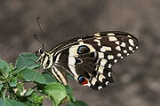
Papilio demodocus
Encyclopedia
Papilio demodocus, also known as the citrus swallowtail, is a large swallowtail butterfly
common to sub-Saharan Africa
. It is a pest species, the caterpillar
feeding on citrus trees.
.
, as they resemble bird droppings. They grow to a length of 10 or 15 mm before changing into mature larvae.
Mature caterpillars lack the camouflage of their immature state. Instead, when threatened by a bird
or other predator, they produce a forked, orange-coloured organ known as an osmeterium
. The organ emits a strong smell which acts as a discouragement to the predator.
, transforming into pupa
e. They remain in the pupal form for 2–3 weeks before emerging as adults.
by certain species of parasitic wasp
, notably Ooencyrtus (eggs) and Pteromalus puparum (pupae).
Swallowtail butterfly
Swallowtail butterflies are large, colorful butterflies that form the family Papilionidae. There are over 550 species, and though the majority are tropical, members of the family are found on all continents except Antarctica...
common to sub-Saharan Africa
Sub-Saharan Africa
Sub-Saharan Africa as a geographical term refers to the area of the African continent which lies south of the Sahara. A political definition of Sub-Saharan Africa, instead, covers all African countries which are fully or partially located south of the Sahara...
. It is a pest species, the caterpillar
Caterpillar
Caterpillars are the larval form of members of the order Lepidoptera . They are mostly herbivorous in food habit, although some species are insectivorous. Caterpillars are voracious feeders and many of them are considered to be pests in agriculture...
feeding on citrus trees.
Life cycle
Citrus swallowtails pass through approximately three generations per year. Eggs are laid singly on citrus tree leaves.Eggs
Female butterflies lay their eggs singly on citrus leaves. After about six days, the egg hatches into an immature larvaLarva
A larva is a distinct juvenile form many animals undergo before metamorphosis into adults. Animals with indirect development such as insects, amphibians, or cnidarians typically have a larval phase of their life cycle...
.
Immature larva
The immature larvae are black, yellow, and white with spikes. Their coloration provides effective camouflageCamouflage
Camouflage is a method of concealment that allows an otherwise visible animal, military vehicle, or other object to remain unnoticed, by blending with its environment. Examples include a leopard's spotted coat, the battledress of a modern soldier and a leaf-mimic butterfly...
, as they resemble bird droppings. They grow to a length of 10 or 15 mm before changing into mature larvae.
Mature larva
Mature larvae are green with white or pink markings and eyespots. They grow to a maximum length of about 45 mm.Mature caterpillars lack the camouflage of their immature state. Instead, when threatened by a bird
Bird
Birds are feathered, winged, bipedal, endothermic , egg-laying, vertebrate animals. Around 10,000 living species and 188 families makes them the most speciose class of tetrapod vertebrates. They inhabit ecosystems across the globe, from the Arctic to the Antarctic. Extant birds range in size from...
or other predator, they produce a forked, orange-coloured organ known as an osmeterium
Osmeterium
The osmeterium is a fleshy organ found in the prothoracic segment of larvae of Swallowtail butterflies including Birdwings. This organ emits smelly compounds believed to be pheromones. Normally hidden, this forked structure can be everted when the caterpillar is threatened, and used to emit a...
. The organ emits a strong smell which acts as a discouragement to the predator.
Pupa
The caterpillars attach themselves to branches with silkSilk
Silk is a natural protein fiber, some forms of which can be woven into textiles. The best-known type of silk is obtained from the cocoons of the larvae of the mulberry silkworm Bombyx mori reared in captivity...
, transforming into pupa
Pupa
A pupa is the life stage of some insects undergoing transformation. The pupal stage is found only in holometabolous insects, those that undergo a complete metamorphosis, going through four life stages; embryo, larva, pupa and imago...
e. They remain in the pupal form for 2–3 weeks before emerging as adults.
Adult
Adult butterflies have black and yellow markings with red and blue eyespots. Female butterflies tend to be larger than males.Natural enemies
Citrus swallowtail eggs and pupae are known to be parasitisedParasitoid
A parasitoid is an organism that spends a significant portion of its life history attached to or within a single host organism in a relationship that is in essence parasitic; unlike a true parasite, however, it ultimately sterilises or kills, and sometimes consumes, the host...
by certain species of parasitic wasp
Parasitic wasp
The term parasitoid wasp refers to a large evolutionary grade of hymenopteran superfamilies, mainly in the Apocrita. They are primarily parasitoids of other animals, mostly other arthropods...
, notably Ooencyrtus (eggs) and Pteromalus puparum (pupae).

